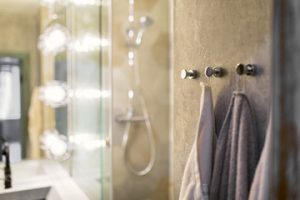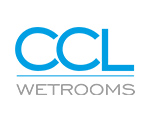
A big concern amongst those considering installing a wet room is how to ensure it is properly waterproofed. Preventing wet room nightmares – especially those relating to leaks – is a primary concern for us here at CCL Wetrooms too, so we’ve put together this list of key considerations that should be made in order to achieve a leak-proof wetroom design.
- Invest in reliable tanking
‘Tanking’ or waterproofing is the layer of membrane between the wetroom drainage and the floor tiles. An effective waterproofing solution is vital within a wetroom to ensure it properly waterproofs your room. Correctly installed tanking will last for the lifetime of the wetroom tiles or in other words, until you come to update your bathroom and replace your tiles. At CCL Wetrooms, we recommend Tilesure Waterproofing & Decoupling Membrane – a self-adhesive wet room waterproofing membrane that provides a suitable surface for natural stone, ceramic and porcelain tiles to be installed onto. Tilesure creates a secure waterproof barrier that is guaranteed for the lifetime of the tiles.
- Ensure you have a quality subfloor
When installing a wet room on a timber floor, an early consideration should be your subfloor. This is the floor foundation which rests on top of the joists, and upon which lays the waterproofing and wetroom tiles. To create a strong and sturdy subfloor, a plywood support should be installed between the joists before the wetroom former is fitted on top. The additional floor support and decoupling membrane will reduce any movement, thus preventing cracks in the tiles or grout, through which water could leak.
- Install adequate drainage
When considering how to waterproof a wet room, it’s important that the drainage has been well-thought out from the point of design. Consideration must be given to:-
- The floor construction of your wetroom. It is imperative that you install drainage that is designed for the floor build up that it will be installed into. A wetroom on a timber floor will require a different drainage system to on a solid Floor.
- The flow rates required for the shower head and the impact on the drainage required.
- The position of the drain – in the floor, up against the wall or along the long shower wall. This will have a bearing on the falls that will need to be installed in the shower area.
- The depth of the wet room floor. In order for water to fully drain away, there must be a sufficient grading within the waste pipe. For wetrooms installed onto a shallow depth floor, appropriate low level drainage traps (such as the Lo-Seal trap) will need to be utilised, rather than a traditional waterseal trap.
- Install tiles correctly
Poor tiling is a common cause of leaks when it comes to wetroom design. If inadequate tiling adhesive or grout has been used, you increase the chance of it coming away from the tanking membrane, which in turn increases the chance of a leak. An S1 or C2 cementitious rapid set tile adhesive is absolutely essential for use in a wetroom and must be used on top of the waterproof membrane. Flexibility is important, as there is constant movement within the floor, especially when the floor structure is timber. When applying the adhesive, the 100% bed of adhesive method must be used rather than the dot and dab method. This prevents water tracking through the gaps under the tiles, leading to leaks.
- Entrust an experienced installer
At CCL Wetrooms, we have more than 30 years of experience in the specification of wetrooms. We offer a complete wet room solution comprising design, manufacture, and the option of a ten year installation guarantee. You can rest assured that our services are second to none, so you can fully entrust us with your wet room design at all stages. Our technical helpline is always available throughout the specification and installation processes, and our specialists are happy to answer any questions you might have.
The addition of a wet room to any premises can have numerous benefits, from improved safety and ease of cleaning, to even increasing the value of a luxury home. Many potential wet room installers are put off by the worry of it leaking – a problem that can be avoided from the wetroom design stage. Contact us today to get your questions answered, or to find out more about installations by CCL Wetrooms.









